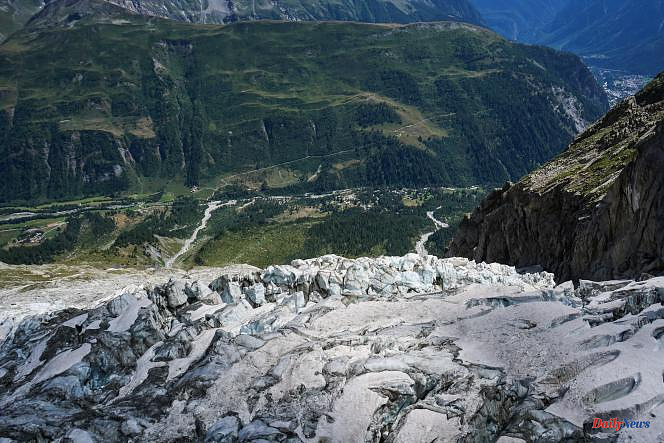"It's a ticking time bomb. In a video posted on his Instagram account, Sébastien Montaz-Rosset does not believe his eyes. We are on February 15, at the foot of the north face of the Grandes Jorasses. In front of the high mountain guide and filmmaker, a gaping chasm opens up which bars access to the Gousseault-Desmaison route. Only a fragile snow bridge makes it possible to cross the bergschrund, a wide crevasse which separates the Leschaux glacier from the rock face. "I stayed a few days at this same place last winter and I can hardly recognize the site as the ice and snow have disappeared. The winter of 2023 is as dry as ever in my eyes and those of my guide and mountaineer friends. The glaciers are suffering and the mountain, in this month of February, looks like the month of May. What do we do ? “, he is indignant.
In the Northern Alps as in the whole of the territory, nothing has fallen for more than a month. "Unheard of during a meteorological winter", alarmed Météo-France, Wednesday, February 22. The month of February, which could show a rainfall deficit of 50%, promises to be "one of the driest on record", continues the agency. Several departments are on drought alert in the middle of winter, such as the Pyrénées-Orientales, which have even been since June. According to the Minister of the Environment, Christophe Béchu, who fears "a catastrophic situation in July", the whole of France is "on alert".
In the Mont-Blanc massif, of which the Grande Jorasses are one of the most emblematic peaks, there has been no rainfall for thirty-five days. In the high mountains, the conditions are comparable to those usually found at the beginning of June, observes Olivier Greber, president of the Compagnie des guides de Chamonix. "They are optimal for mountaineering, which is very pleasant, but it is also very worrying", he underlines, fearing that the drought will jeopardize not only his practice, but the whole fragile mountain ecosystem. . Is this situation, due to the stagnation of a powerful anticyclone centered since January on the British Isles, really unprecedented?
"The eternal snows are no longer eternal"
"The snow cover is certainly low, but it is not exceptional", answers Denis Roy, head of Météo-France for the Northern Alps. "It's a situation you encounter every ten or fifteen years. It varies according to altitude but, in the middle mountains, that is to say between 1200-1700 m, the winters of 1989-1990, 1992-1993 and 2006-2007 were comparable, "he continues. The snow depth measured at the Col de Porte, 1,325 m above Grenoble, however fell to 12 centimeters. Only February 21, 1990 saw so little snow on this site where measurements began in 1960.
"At home, in Puy-Saint-Vincent, on the border between the Northern and Southern Alps, we were even better off than last year", welcomes Bernard Francou, research director emeritus at the Institute for Development Research and author of Hot Shot on the Mountains (Editions Paulsen, 2021). After a month of drought, the snow that fell at the start of winter has held up well and "the mountain remains white", as Météo-France put it in its latest weekly bulletin.
The deficit therefore does not seem so catastrophic, at least in the short term. Thanks to artificial snow, which has made it possible to fill it in and solidify the snowpack, the slopes remain open for the holidays in most ski resorts in the Alps, but what worries Bernard Francou is not the fate of skiers, but that of glaciers. Combined with constant warming, in both summer and winter, the chronic drought considerably accelerates their melting. Glacial ablation, i.e. the reduction in the volume of ice, has already reached record highs in 2022 and so the situation seems to be repeating itself this year:
"According to the measurements of the Ecrins National Park, the melting of the Blanc glacier, in the Vallouise valley, which I can see from my window, has caused the level of the Serre-Ponçon lake to rise by 60 centimeters, which is totally unprecedented. This is also the case for all the other glaciers in the Alps. In very icy basins, such as that of the Chamonix valley, this swells the flow of rivers, which can cause glacial floods, even without precipitation. It is good for agriculture, but the reserves are running out. If the trend continues, glaciers will lose much of their mass and summer flows will become lower and lower."
Eventually, they could even dry up completely. “All the scenarios show that we are heading, by the end of this century, towards the disappearance of very many glaciers. According to the most pessimistic, temperatures will increase by 3°C on average on a global scale by 2100 and it will be much more in the mountains. By then, there are barely three generations, warns the researcher. When the children born today turn 80, most of the glaciers in the Alps will be gone. What used to be called the eternal snows are no longer so. »












